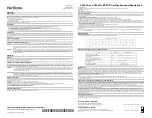
Parameterization and commissioning
EL6751
122
Version: 3.5
DATA[1], Bit 7: 1 = RTR (the length then indicates the number of data to be read, no data follows
the message, the next CAN message starts at DATA [3]
DATA[2]: Length of the 1st CAN-Message
DATA[3-n]: Data of the 1st CAN-Message
DATA[(n+1)]: 2nd CAN-Message, CAN-Id Bit 0-7
etc.
Enable / disable CAN messages for receiving
For receiving, the CAN IDs must first be activated.
AdsWrite:
NETID = AoeNetId der EL6751
PORT = 200
IDXGRP = 16#F923
IDXOFFS = 0
LEN = Number of CAN-IDs * 2
DATA[0]: 1st CAN-ID, Bit 0-7
DATA[1]: 1st CAN-ID, Bit 8-11,
Bit 15=0: Activate for receiving
Bit 15=1: Deactivate for receiving
DATA[2]: 2nd CAN-ID, Bit 0-7
etc.
Reading the received CAN messages
AdsRead:
NETID = AoeNetId der EL6751
PORT = 200
IDXGRP = 16#F921
IDXOFFS = 0
LEN = 640 (maximum buffer size)
The DATA has the same structure when sending the CAN messages.
The buffer in the EL6751 comprises approx. 50 CAN messages (with 8 bytes of data per frame).
This feature is available from FW18.
5.5
EtherCAT communication EL6751
5.5.1
CANopen master
5.5.1.1
EtherCAT State Machine
The EL6751 can be configured in several ways:
1.
Configuration of the EL6751 with StartUp SDOs [
: Here, the StartUp SDOs are calculated in the
EtherCAT configurator and transferred to the EtherCAT master, in the same way as is carried out, for
example, in the TwinCAT System Manager.
2.
Configuration of the EL6751 by scanning the CAN bus [
: Here, the EL6751 is ordered to scan the
CAN bus and to save the CANopen configuration found there in the InfoData objects.
















































